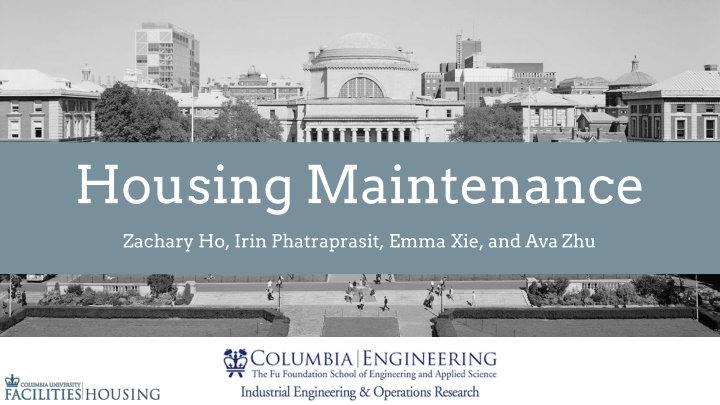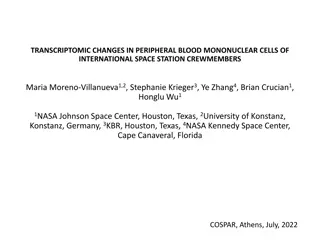
Optimizing Housing Maintenance Schedules Using Simulation and Algorithms
Explore how to improve housing maintenance by utilizing simulation models and advanced algorithms. Learn about Smith's Rule and the CONVERT method for scheduling jobs efficiently based on severity and completion times. Enhance student life at Columbia University by reducing maintenance completion times and minimizing wait periods.
Download Presentation

Please find below an Image/Link to download the presentation.
The content on the website is provided AS IS for your information and personal use only. It may not be sold, licensed, or shared on other websites without obtaining consent from the author. If you encounter any issues during the download, it is possible that the publisher has removed the file from their server.
You are allowed to download the files provided on this website for personal or commercial use, subject to the condition that they are used lawfully. All files are the property of their respective owners.
The content on the website is provided AS IS for your information and personal use only. It may not be sold, licensed, or shared on other websites without obtaining consent from the author.
E N D
Presentation Transcript
Housing Maintenance Zachary Ho, Irin Phatraprasit, Emma Xie, and Ava Zhu
Our Goal Background Students can request for housing maintenance by filling in an online form, calling, or emailing housing Jobs are to be completed within 3-14 days No current scheduling rules Objective Reduce maintenance request completion time to below 9 days and improve student life at Columbia University Minimize the average time a student has to wait for the job to be complete
Simulation Formulation: 1. Grouped maintenance types into 3 severities - high(1), medium(2), low(3) 2. Assumptions: - Low severity job occurs with the highest probability - Service time for high, medium, and low severity is 3, 9, 14 days respectively - Poisson arrivals and exponential service times - Limiting scope to 1 residence hall Recalculate schedule every time a new
Generated Data wj/pj 0.93 1.37 22.22 6.67 2.94 5.88 3.13 1.22 2.82 1.52 3.77 0.51 1.74 5.56 1.72 2.88 6.00 j rj wj 2 2 2 2 3 3 3 3 2 3 2 1 2 2 3 3 3 pj Python output: 1 2 3 4 5 6 7 8 9 10 11 12 13 14 15 16 17 0.01 0.09 0.18 0.19 0.25 0.26 0.28 0.32 0.53 0.54 0.55 0.59 0.65 0.78 0.81 0.82 0.97 2.15 1.46 0.09 0.3 1.02 0.51 0.96 2.45 0.71 1.97 0.53 1.95 1.15 0.36 1.74 1.04 0.5 Problem we are trying to solve: Objective Function: 3 | rj | wjCj NP-Hard Assume machines are number of workers: m = 3 rj - the time when ticket is submitted wj - the severity of request pj - processing time (service time) Data snapshot at time t
Method 1 -Smiths Rule Results: Algorithm: Step 1: Construct non-preemptive schedule using Smith s rule, wj/pj decreasing Average wait time (Cj - rj) = 2.67 wjCj = 124.39 Step 2: Assign jobs to machine that has completed task Step 3: Ensure that job does not start before release date Schedule:
Method 2 - CONVERT According to the algorithm CONVERT, the 1-machine model works for multiple parallel machines. Step 1: Construct pre-emptive schedule on single machine Algorithm by Smith: At any time we schedule the job j with the greatest Smith ratio wj/pj, where pjis the remaining processing time of job j. Step 2: Form a list L of the jobs, ordered by their pre-emptive completion times. Step 3: List schedule non-preemptively using L, with the constraint that no job J starts before its release date rj. To slightly simplify our analysis, we specify that our list scheduling algorithm will not start the jth job in L until the (j - 1)st is completed (in the one machine environment) or started (in the parallel machine environment) *There is an on-line non-preemptive 2-approximation algorithm for 1 | rj | Cj Given a schedule P for 1 | rj, pmtn | wjCj, algorithm CONVERT produces a schedule N for the corresponding instance of 1 | rj l wjCj with C_N 2C_P. *
Algorithm 2 -CONVERT Results: Average wait time (Cj - rj) = 2.62 wjCj = 126.99
Results and Recommendations Both algorithms delivered an average waiting time lower than the range provided by housing Smith s Algorithm and CONVERT Algorithms produce close results After various trials, CONVERT Algorithm was shown to have slight improvement over Smith s Algorithm Next Steps: Run algorithm with real data Explore other types of algorithms e.g. Maintenance Scheduling

